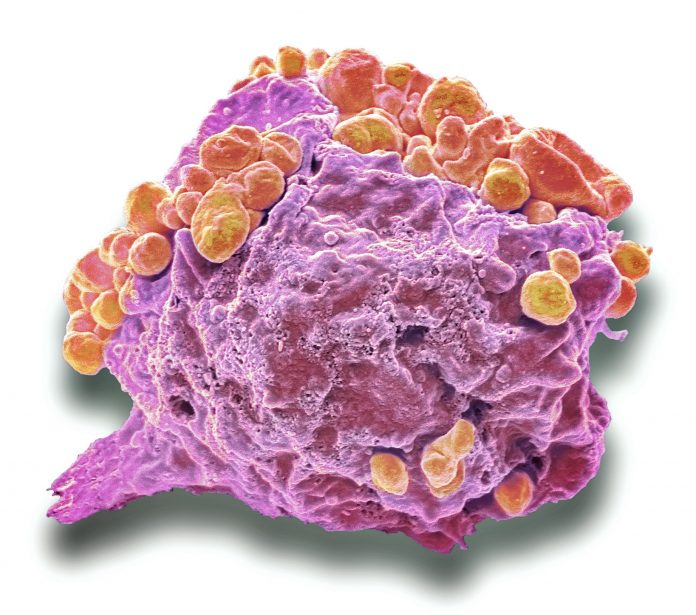
New research from scientists at the City of Hope in Los Angeles, CA has shed light on a novel oncogenic pathway in B cell malignancies. Their research, published in Cell, identifies the YTHDF2 enzyme as a critical player in the development and progression of B cell malignancies, including B cell acute lymphoblastic leukemia (B-ALL) and B cell lymphomas. This discovery enhances the understanding of the molecular mechanisms driving these cancers and opens up new possibilities for therapeutic interventions.
The dual role of YTHDF2: Energy supply and immune evasion
At the heart of this research is the YTHDF2 enzyme, which the researchers describe as a “dual reader” of RNA modifications. YTHDF2 plays a pivotal role in both enhancing ATP synthesis and promoting immune evasion in malignant B cells. As co-corresponding author Jianjun Chen explained, “YTHDF2 functions as a dual reader where it stabilizes mRNAs as a 5-methylcytosine (m5C) reader via recruiting PABPC1, thereby enhancing their expression and ATP synthesis. This mechanism is crucial for malignant B cells’ rapid proliferation and survival, which require an efficient energy supply to thrive.”
YTHDF2 also promotes immune evasion by destabilizing other mRNAs as an N6 methyladenosine (m6A) reader.
One of the challenges in treating blood cancers is the ‘antigen escape’ of proteins essential for immune recognition, such as the CD19 protein and HLA-DMA/B. In 28-68% of cases, cancer cells lower or lose CD19, making treatments less effective.
“We found that YTHDF2 also suppresses the expression of CD19 and HLA-DMA/B as an m6A reader, enabling tumor cells to escape from CAR-T cell attack,” explained first author Zhenhua Chen. This dual functionality allows YTHDF2 to facilitate immune evasion.
The discovery of YTHDF2’s dual role in B cell malignancies is part of a broader effort to understand the complex interplay of RNA modifications in cancer biology. RNA modifications, such as m5C and m6A, play crucial roles in regulating gene expression and cellular function. Proteins like YTHDF2, which recognize and interpret these modifications, are emerging as key players in cancer development and progression.
A Promising therapeutic target: The YTHDF2 inhibitor CCI-38
The study’s findings have significant implications for treating B cell malignancies, particularly in the context of chimeric antigen receptor (CAR)-T cell therapy. Despite the success of CAR-T cell therapy in achieving remission in many patients, long-term durable remission remains a challenge due to antigen escape. The researchers’ discovery that YTHDF2 overexpression contributes to antigen escape provides a new target for therapeutic intervention.
The team developed CCI-38, a small-molecule inhibitor, to target YTHDF2. This inhibitor has shown promise in suppressing aggressive B cell malignancies and sensitizing them to CAR-T cell therapy. Jianjun Chen noted, “Our compound, CCI-38, has unique properties that selectively target YTHDF2, enhancing CD19 expression and reducing tumor burden.” By inhibiting YTHDF2, CCI-38 not only restores antigen expression but also reduces the energy supply to malignant cells, thereby enhancing the efficacy of CAR-T cell therapy.
Implications for future research and clinical applications
The implications of this research extend beyond the immediate findings. The dual role of YTHDF2 in both energy metabolism and immune evasion highlights the complexity of cancer biology and underscores the need for multifaceted therapeutic approaches. In the context of B cell malignancies, the high expression of YTHDF2 in malignant cells compared to healthy controls suggests that it may serve as a biomarker for disease progression and a potential target for therapeutic intervention.
The researchers emphasize the potential of YTHDF2 as a therapeutic target in B cell malignancies and other cancer types that rely on mitochondrial ATP synthesis.
Jianjun Chen noted, “The dual reader activity of YTHDF2 is crucial for its pivotal oncogenic role in B cell malignancies. By targeting this pathway, we have the opportunity to not only improve treatment outcomes for B cell malignancies but also explore new therapeutic avenues for other cancer types.”
Furthermore, the study opens up new avenues for optimizing CAR-T cell therapy. By co-treating patients with a YTHDF2 inhibitor like CCI-38, reducing the required CAR-T cell dose may be possible, thereby minimizing treatment-related toxicities and costs. This approach could transform the way we treat relapsed or refractory B cell malignancies, offering new hope for patients who have exhausted other treatment options.











